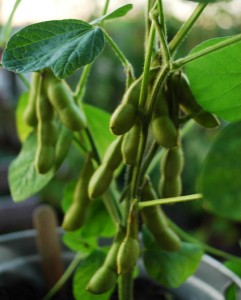09
Aug
Farmers Dealing with Fall-Out from Monsanto’s New GE Crops
 (Beyond Pesticides, August 9, 2016) Farmers in Missouri, Arkansas, and Tennessee are confronting widespread crop damage and bracing for lower yields as a result of agrichemical giant Monsanto’s botched roll-out of new genetically engineered soybean and cotton crops. The company, whose current line of glyphosate-tolerant crops are failing to control weeds throughout the U.S. and across the globe, developed a new line of soybean and cotton with traits that make it tolerate applications of an older herbicide dicamba. However, while its seeds are available for purchase on the market, and Monsanto is encouraging farmers to grow them, the company has yet to receive EPA regulatory approval for the dicamba herbicide meant to be used with the plants.
(Beyond Pesticides, August 9, 2016) Farmers in Missouri, Arkansas, and Tennessee are confronting widespread crop damage and bracing for lower yields as a result of agrichemical giant Monsanto’s botched roll-out of new genetically engineered soybean and cotton crops. The company, whose current line of glyphosate-tolerant crops are failing to control weeds throughout the U.S. and across the globe, developed a new line of soybean and cotton with traits that make it tolerate applications of an older herbicide dicamba. However, while its seeds are available for purchase on the market, and Monsanto is encouraging farmers to grow them, the company has yet to receive EPA regulatory approval for the dicamba herbicide meant to be used with the plants.
A spate of news reports over the past two months in southern soybean growing regions finds that many farmers are illegally applying off-label dicamba-based herbicides to Monsanto’s new GE crops in an effort to control weeds resistant to glyphosate. Use of this highly volatile herbicide is causing widespread crop damage not only to soybeans that don’t carry the resistance trait, but other crops in the region, including peaches, melons, and tomatoes.
Dicamba has a strong propensity to volatilize small particles of the herbicide into the air and drift far off-site. Sensitive crop species can be damaged by dicamba at levels in the parts per million. A study published by Pennsylvania State scientists in late 2015 found dicamba drift was “frequently responsible for sublethal, off-target damage” to plants and insects. Researchers found that even very low rates of dicamba herbicide exposure negatively impacted plant flowering, and thus insect pollination.
Monsanto is encouraging farmers to plant its dicamba-tolerant seeds because the company claims it also creates higher yields. The company told NPR that it made clear to farmers that they could not spray dicamba on its dicamba-tolerant crops.
However, many farmers are concerned about their livelihood as a result of Monsanto’s aggressive marketing of its product without full regulatory approval. “If we don’t do anything to stop this, it’s going to happen year after year until everyone’s planting dicamba-resistant crops or they’re not planting anything at all. . . That seems to be the path we’re on,” said Kade McBroom, a farmer and operator of Malden Specialty Soy, to LakeExpo.com.
Already in four Missouri Bootheel counties over 100 complaints of pesticide drift have been reported since mid-June. The Missouri Department of Agriculture indicates that it usually receives 75 to 80 complaints of pesticide misuse each year for the entire state.
Despite data showing glyphosate resistance to at least 29 weed species worldwide, Monsanto and other agrichemical companies have insisted on doubling down on their failed technology, opting to create new GE cropping systems that incorporate older, more toxic herbicides. Dicamba has been linked to damage of the kidney and liver, neurotoxicity, and developmental impacts. Another GE cropping system, developed by Dow Agrosciences relies on the herbicide 2,4-D, a chemical linked to non-Hodgkins Lymphoma (NHL), and is also neurotoxic, genotoxic, and an endocrine disruptor. Both of the herbicides associated with these GE crops remain formulated with glyphosate, which the International Agency for Research on Cancer (IARC) recently identified as carcinogenic to humans based upon laboratory animal studies. In fact, synergy, the potential for pesticide mixtures to increase or decrease the potency of the formulated product, is the main reason why EPA is rethinking its approval of Dow’s 2,4-D/glyphosate herbicide.
Southern soybean farmers are specifically concerned over the spread of glyphosate-resistant palmer amaranth, or pigweed, which can significantly reduce yields. In 2014, cotton farmers in Texas requested an emergency application under Section 18 of the Federal Fungicide, Insecticide, and Rodenticide Act to use the highly toxic herbicide propazine to control resistant palmer amaranth in their fields. EPA denied their request citing the danger of groundwater contamination, but recognized that the situation warranted an emergency exemption, a point with which Beyond Pesticides strongly disagrees.
Weed resistance is an entirely predictable occurrence in fields where herbicides are sprayed incessantly during the growing season. Even the use of older, more toxic herbicides will only slow resistance down briefly. Research out of the University of Arkansas was able to create dicamba-resistant palmer amaranth in a greenhouse after only three generations. Farmers should expect similar results in the field, regardless if they’re applying registered or illegal, off-label dicamba products.
While Missouri lawmakers contemplate increasing fines on illegal pesticide applications, ultimately, this problem will need to be addressed on a structural scale, as conventional farmers will need to diversify the crops they plant and implement other cultural practices to deter weeds, such as cover crops, crop rotation, and intercropping. Food distribution systems will also need to shift to accommodate greater diversity in farmer fields. Organic agriculture represents a time-tested approach to managing weeds and avoiding resistance problems that plague GE cropping systems. With organic, the use of toxic synthetic herbicides and GE seeds is prohibited, and farmers must craft an organic system plan aimed at improving soil health and managing pests and weeds should they arise.
All unattributed positions and opinions in this piece are those of Beyond Pesticides.
Sources: LakeExpo.com, NPR, Farms.com










